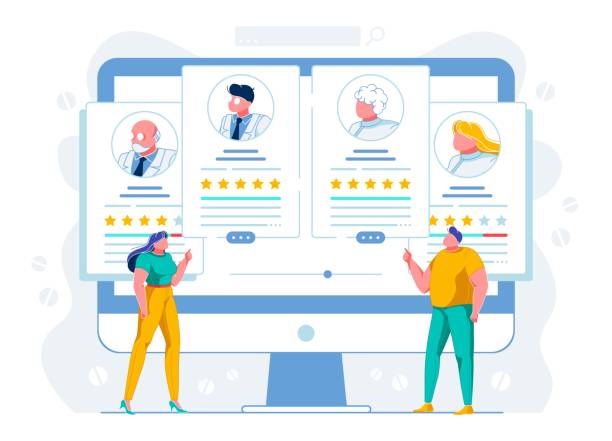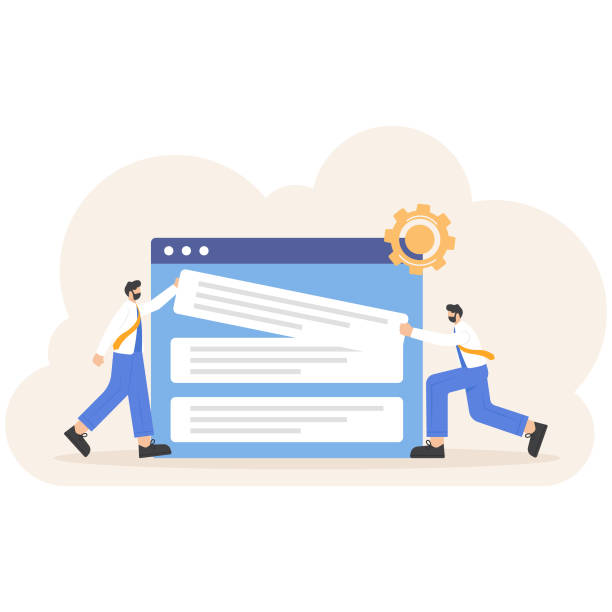The Importance of Entering the Digital World and Designing an E-commerce Website

In the current era, online presence has become more vital than ever for any business.
#E-commerce website design is no longer a luxury option, but a necessity for survival and growth in competitive markets.
This paradigm shift has provided countless opportunities for businesses to transcend geographical boundaries and reach customers from all over the world.
An e-commerce website is a 24/7 storefront that allows customers to access your products or services anytime, anywhere.
This not only increases convenience for the customer but also significantly reduces operational costs for the business.
Beyond cost savings and increased accessibility, e-commerce website design provides a platform for brand building and fostering deeper connections with customers.
Through a professional website, you can tell your brand story, showcase your values, and build customer trust.
Furthermore, the analytical capabilities of e-commerce websites allow you to monitor customer behavior and optimize your marketing and sales strategies based on real data.
This is a long-term investment that will yield significant returns and put your business on a path of sustainability and success.
With optimized e-commerce website design, you not only sell products but also provide an unforgettable online shopping experience to your customers.
Are you bothered by losing customers due to your e-commerce site’s outdated appearance or slow speed? RasaWeb’s expert team solves these problems with professional e-commerce website design!
✅ Increase customer trust and brand credibility
✅ Stunning speed and excellent user experience
Get a free consultation with RasaWeb right now ⚡
Key Elements for Success in an Online Store

To achieve success in #e-commerce, merely having a website is not enough; key elements must be incorporated into your e-commerce website design.
The first and most important element is simplicity and ease of use (UX).
Customers should be able to easily find their desired products, add them to the cart, and complete the payment process without any complications.
The smoother this path, the higher the Conversion Rate will be.
An attractive and professional visual design is also of high importance.
High-quality images, accurate and complete product descriptions, and logical and intuitive navigation are factors that attract and retain customers.
Security is also a vital element in an online store.
Customers must feel secure that their personal and financial information is protected during a purchase.
The use of SSL certificates, secure payment gateways, and adherence to security standards are fundamental principles in this regard.
Furthermore, website loading speed directly impacts user experience and SEO ranking.
No user is willing to wait a long time for a page to load.
Customer support is also a key element; providing various communication channels such as online chat, phone, and email, and responding quickly and effectively to questions and problems, builds customer trust and helps with their loyalty.
All these elements together create a successful e-commerce website design that not only increases sales but also builds a positive image for your brand.
User Experience (UX) and User Interface (UI) in E-commerce Website Design
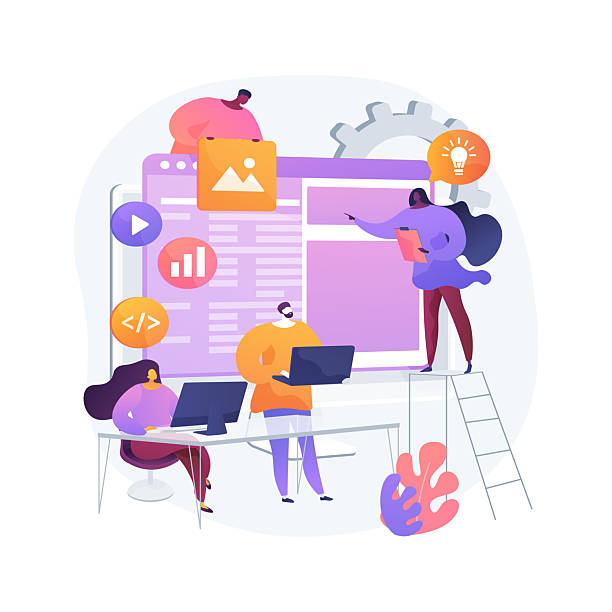
User Experience (UX) and User Interface (UI) are two main pillars in #e-commerce website design that guarantee the success of an online store.
UX refers to the overall feeling and experience of the user when interacting with the website, while UI deals with the website’s appearance and visual elements.
A strong UX means easy navigation, a straightforward purchasing process, and a logical design that guides the user towards their goal (purchase).
This includes optimizing steps from product search to final payment, reducing unnecessary steps, and providing appropriate feedback to the user.
In contrast, an attractive and consistent UI makes your website appear professional and trustworthy, which directly impacts the user’s willingness to continue browsing and ultimately make a purchase.
For excellent UX/UI e-commerce website design, even small details must be considered.
Appropriate color schemes, readable fonts, proper use of whitespace, and compatibility with various displays (mobile, tablet, desktop) are among the important UI considerations.
From a UX perspective, providing advanced filters and search options, displaying customer reviews, product comparison features, and offering related suggestions all contribute to an improved shopping experience.
Furthermore, page loading speed and the website’s responsiveness to user actions play a significant role in retaining users.
A slow or confusing website quickly frustrates users and drives them towards your competitors.
Therefore, investing in strong UX/UI design not only increases sales but also solidifies your brand in the minds of customers.
In the following, a table of UX/UI best practices for e-commerce website design is presented:
| Factor | UX Description | UI Description |
|---|---|---|
| Navigation | Clear and short paths to reach the product and complete the purchase. | Simple menus, clear categories, visual icons. |
| User Forms | Shortening forms, input validation, clear error messages. | Simple and readable design, sufficient spacing, clear call-to-action buttons. |
| Product Pages | Comprehensive information, customer reviews, related suggestions. | Quality images, appropriate fonts, prominent “Add to Cart” button. |
| Performance | High loading speed, quick response to clicks. | Smooth animations, no delay in loading elements. |
Choosing the Right Platform for Your Online Store

One of the crucial decisions in the #e-commerce website design process is choosing the right platform.
This choice not only affects development cost and time but also determines the future capabilities of your website.
Various platforms with diverse features and functionalities are available in the market, each with its own advantages and disadvantages.
Popular options include open-source content management systems like WooCommerce on WordPress, cloud platforms like Shopify, and custom-built solutions.
The right choice depends on your budget, business scale, technical needs, and desired level of control.
WooCommerce, a powerful plugin for WordPress, offers great flexibility and control.
This option is suitable for businesses seeking a cost-effective solution with extensive customization capabilities.
However, it requires more technical knowledge for setup and maintenance.
Shopify, as a cloud platform, offers ease of use and quick setup, which is ideal for small to medium-sized businesses looking for a ready-made solution.
But it has monthly costs and customization limitations.
Custom-built solutions offer ultimate flexibility and can be designed precisely to your business’s specific needs, but they are usually more expensive and time-consuming.
Finally, before starting your e-commerce website design, a thorough review of your business needs and a comparison of each platform’s features and costs are essential to make the best choice for your path forward.
A deep understanding of these options can guarantee the future success of your online store.
Did you know a weak corporate website costs you many opportunities daily? Solve this problem forever with professional corporate website design by RasaWeb!
✅ Create a powerful and trustworthy image for your brand
✅ Targeted attraction of new customers and increased sales
⚡ [Get a free website design consultation]
Payment Security and Bank Gateways in Online Stores
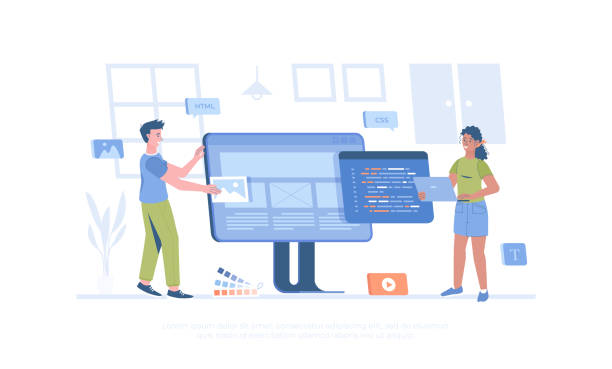
Payment security is the backbone of customer trust in any #online store.
Without a secure and reliable payment system, even the best e-commerce website design cannot succeed.
Customers must be confident that their financial information is fully protected during a purchase.
This includes data encryption, adherence to PCI DSS (Payment Card Industry Data Security Standard) security standards, and the use of secure protocols such as SSL/TLS.
An SSL certificate, indicated by a green padlock in the browser’s address bar, signifies a secure connection and is essential for any e-commerce website.
Choosing and configuring appropriate payment gateways is also a crucial part of this process.
Payment gateways are intermediaries between your website and banks or payment networks.
In Iran, direct bank payment gateways or intermediary payment gateways (such as ZarinPal or IDPay) are commonly used.
Each of these has its own advantages and disadvantages; direct gateways may have lower fees but a more complex activation process, while intermediary gateways activate faster and offer better support services but might charge higher fees.
For e-commerce website design, you must choose a system that is both secure and provides a smooth user experience for customers.
Transparency in fees, clear display of payment steps, and offering diverse payment options (such as card-to-card, installment payments) can also significantly help increase conversion rates and customer satisfaction.
The importance of this aspect of payment gateway in the ultimate success of e-commerce website design is undeniable.
The Importance of Responsive Design and SEO in E-commerce Websites

In today’s world, most users access the internet via mobile devices, hence, #e-commerce website design with Responsive Design is no longer a competitive advantage, but a requirement.
A responsive website means that the design and layout of pages automatically adapt to the screen size of the user’s device (whether mobile, tablet, or desktop) and provide the best user experience.
This is not only crucial for user convenience, but Google also prefers responsive websites in its search results rankings, which directly impacts your website’s SEO.
SEO is of particular importance for an e-commerce site, as it helps you achieve a higher ranking in search results for keywords related to your products and attract more organic (free) traffic.
Optimizing keywords in product titles, descriptions, URL addresses, and even images can help search engines better understand your content.
Website loading speed, SEO-friendly URL structure, creating a sitemap and robots.txt file, and building quality backlinks are all important factors in SEO.
Additionally, providing high-quality and unique content (such as educational blogs and product reviews) can help increase your website’s authority with search engines.
Ultimately, an e-commerce website design that is both responsive and adheres to SEO principles not only improves user experience but also significantly increases your chances of being seen and attracting new customers.
The Art of Product Photography and Engaging Descriptions in an Online Store
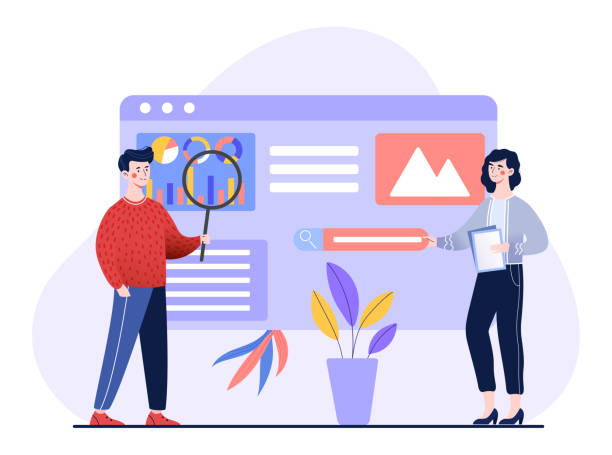
In an #online store, a customer cannot touch or closely examine the product, therefore, high-quality images and engaging product descriptions play a vital role in the purchasing decision.
The art of product photography for e-commerce website design goes beyond simply taking a picture; it must showcase the product in the best possible condition, with appropriate lighting, various angles, and precise details.
Using high-resolution images with zoom capability allows the customer to view even the smallest details of the product.
Displaying the product in real environments or with a model can help the customer form a better idea of how to use or how the product looks.
Along with quality images, product descriptions must also be compelling and comprehensive.
These descriptions should not only state the technical specifications of the product but also focus on its benefits for the customer.
Engaging language, storytelling, and answering potential customer questions can make your descriptions less dry and lifeless.
For example, instead of simply saying “This phone has a 10-megapixel camera,” say “Capture your unforgettable moments with unparalleled quality using this phone’s 10-megapixel camera.”
Additionally, information such as dimensions, weight, material, warranty, and shipping method should be clearly stated.
Don’t overlook optimizing descriptions for product-related keywords to achieve a better ranking in search results.
An e-commerce website design with strong images and descriptions assures the customer they will be satisfied with their purchase and also reduces the product return rate.
This combination of professional photography and impactful text is, quite literally, the difference between a visitor and a loyal customer.
| Element | Key Product Photography Tips | Key Product Description Tips |
|---|---|---|
| Quality | Use of high resolution, appropriate lighting, clean background. | Accurate, comprehensive, free of typos, answers to frequently asked questions. |
| Angles | Display product from various angles, details, usage. | Stating features and benefits, emphasizing solving customer problems. |
| Content | 360-degree photos, short introductory videos (if possible). | Storytelling, engaging tone, use of keywords for SEO. |
| Technical Information | Showing scale by placing next to a reference object. | Technical specifications, dimensions, weight, material, instructions. |
Marketing and Advertising Strategies to Increase Online Sales
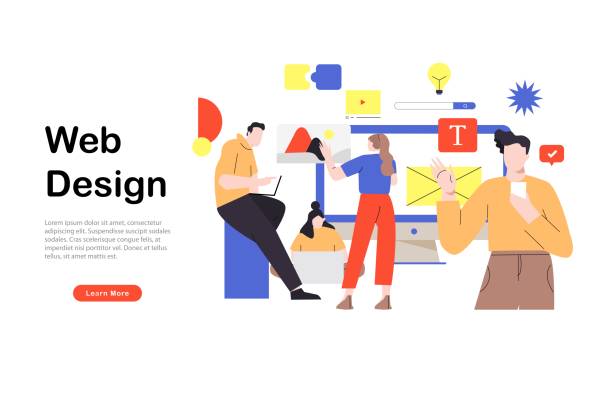
After completing #e-commerce website design, the next stage is customer acquisition and increasing sales.
This requires a comprehensive and targeted marketing and advertising strategy.
Simply having a beautiful website is not enough; you must ensure that your target audience is aware of its existence and is directed towards it.
One of the most powerful tools is content marketing.
Creating educational blogs, specialized articles, buying guides, and engaging videos related to your products not only helps improve SEO but also establishes you as an authority in your field and builds customer trust.
Using paid advertising is also an effective way to quickly increase traffic.
Google Ads campaigns allow you to appear at the top of search results for specific keywords.
Social media advertising on platforms like Instagram, Telegram, and Facebook are also highly effective for targeting specific audiences and building brand awareness.
Email marketing is also a powerful tool for maintaining communication with existing customers and converting visitors into customers.
Sending newsletters, special offers, and notifications about new products can lead to increased customer loyalty and repeat purchases.
Collaborating with influencers, launching discount campaigns and contests, and offering promotional coupons can also help attract new customers.
All these strategies should be aligned with the overall goals of your online store and continuously monitored and optimized to achieve the highest return from your e-commerce website design.
Are you frustrated with your online store’s low conversion rate?
RasaWeb, with its professional e-commerce website design, is your definitive solution!
✅ Increase your sales and revenue
✅ Unforgettable user experience for your customers
⚡ Get a free consultation now!
Support and Maintenance After Launching an Online Store
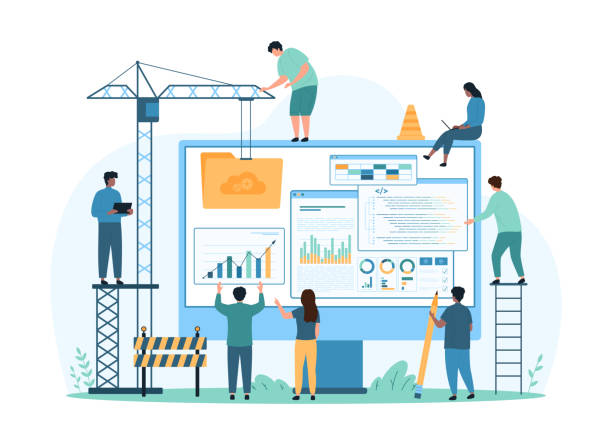
The successful launch of an #e-commerce website design is not the end, but the beginning of a long journey of maintenance, updates, and support.
An e-commerce site that is not regularly maintained may encounter security issues, lose speed, or even go offline.
Regular software updates (such as WordPress core, WooCommerce, and plugins) are essential for maintaining website security and functionality.
These updates not only fix bugs but also add new features and ensure the website’s compatibility with new browsers and devices.
Technical support is also of high importance.
In case of any technical issues, such as payment gateway failures, incorrect product display, or hosting-related problems, an expert and available team must be present to quickly resolve these issues.
Delays in resolving these issues can lead to lost sales and customer dissatisfaction.
Furthermore, Customer Support is an inseparable component.
Quick and effective responses to customer questions, complaints, and problems through various channels such as online chat, phone, email, and social media, can significantly help increase customer satisfaction and loyalty.
Also, monitoring website performance using analytical tools like Google Analytics to identify strengths and weaknesses, user behavior, and optimization opportunities is essential.
A stable and successful e-commerce website design always requires continuous maintenance and attention to detail to achieve its goals in the long run.
This approach ensures that your investment in e-commerce website design pays off.
Data Analysis and Continuous Optimization for Store Growth

After launching and maintaining an #online store, the next stage for sustainable growth and success is data analysis and continuous optimization.
Merely having an optimized e-commerce website design at the outset is not enough; the market, customer behavior, and search engine algorithms are constantly changing.
Data analysis tools like Google Analytics, Google Search Console, and e-commerce platform analytics tools provide valuable information about your website’s performance.
This information includes the number of visitors, most visited pages, Bounce Rate, user session duration, purchase paths, conversion rate, and traffic sources.
By analyzing this data, you can identify the strengths and weaknesses of your online store.
For example, if you notice a high bounce rate on product pages, you might need to improve product images or descriptions.
If the conversion rate at the payment stage is low, perhaps the payment process is complicated or there aren’t enough payment options.
Continuous optimization (CRO – Conversion Rate Optimization) means making small, targeted changes based on these analyses with the goal of increasing the percentage of visitors who convert into customers.
This includes A/B testing for various parts of the website such as titles, call-to-action buttons, page layouts, and images.
Furthermore, monitoring keywords and their rankings in search results and adjusting SEO strategy accordingly is another aspect of continuous optimization.
With an analytical approach and continuous optimization, your e-commerce website design will always be improving and growing, helping you stay ahead in the competitive e-commerce market and achieve your sales goals.
Frequently Asked Questions
| Row | Question | Answer |
|---|---|---|
| 1 | What is an e-commerce website? | It is a website that enables the online buying and selling of products or services, allowing users to view, select, and purchase products. |
| 2 | Why do we need e-commerce website design? | With an e-commerce site, businesses can reach a wider audience, operate 24/7, reduce operational costs, and increase their sales. |
| 3 | What are the main features of a successful e-commerce website? | Product catalog, shopping cart, secure payment gateway, order management system, user panel, product search and filter capabilities, and responsive design. |
| 4 | What are the common platforms for e-commerce website design? | Common platforms include WordPress (with WooCommerce plugin), Shopify, Magento, PrestaShop, or custom development (coding from scratch). |
| 5 | What is the importance of User Interface (UI) and User Experience (UX) in e-commerce website design? | Proper UI/UX design improves customer experience, reduces bounce rate, increases user session duration, and ultimately boosts conversion rates and sales. |
| 6 | What are the key stages of designing an e-commerce website? | These stages include planning and research, visual and UI design, technical development and coding, content entry, testing and troubleshooting, launch, and support. |
| 7 | What is the importance of security in e-commerce websites? | Security is vital for protecting sensitive user information (such as payment and personal data) and building customer trust. The use of SSL certificates and secure payment gateways is essential. |
| 8 | What does SEO mean for an e-commerce website? | It is the optimization of the website for search engines like Google, so that product and category pages appear higher in search results and attract more organic (free) traffic. |
| 9 | What is the role of payment gateways in an e-commerce website? | A payment gateway is a bridge between the customer and the bank that facilitates secure online financial transactions and transfers money from the customer’s account to the seller’s account. |
| 10 | What does Responsive Design mean for an e-commerce website? | It means that the e-commerce website should display correctly and be easy to use on any device (mobile, tablet, laptop), without losing information or having a messy appearance. |
And other services of RasaWeb Advertising Agency in the field of advertising
Smart Reportage: A combination of creativity and technology to increase website visits through intelligent data analysis.
Smart Google Ads: An effective tool for user engagement with the help of Google ad management.
Smart Custom Software: Designed for businesses seeking to analyze customer behavior through key page optimization.
Smart Sales Automation: A novel service for increasing digital branding through user experience customization.
Smart Social Media: A creative platform for improving SEO ranking by optimizing key pages.
And over hundreds of other services in the field of internet advertising, advertising consultation, and organizational solutions
Internet Advertising | Advertising Strategy | Advertorial
Sources
Successful E-commerce Website Design: Principles and Key Tips
Complete Guide to Professional E-commerce Website Design
The Importance of UI and UX in Online Store Design
Scientific Principles of Modern E-commerce Website Design
? Are you ready to transform your business in the digital world? RasaWeb Afarin Digital Marketing Agency, by providing comprehensive and innovative solutions, including fast website design and professional optimization, paves your way to success. With us, have a powerful and lasting presence in the online space.
📍 Tehran, Mirdamad Street, next to Central Bank, Southern Kazeroun Alley, Ramin Alley, No. 6

